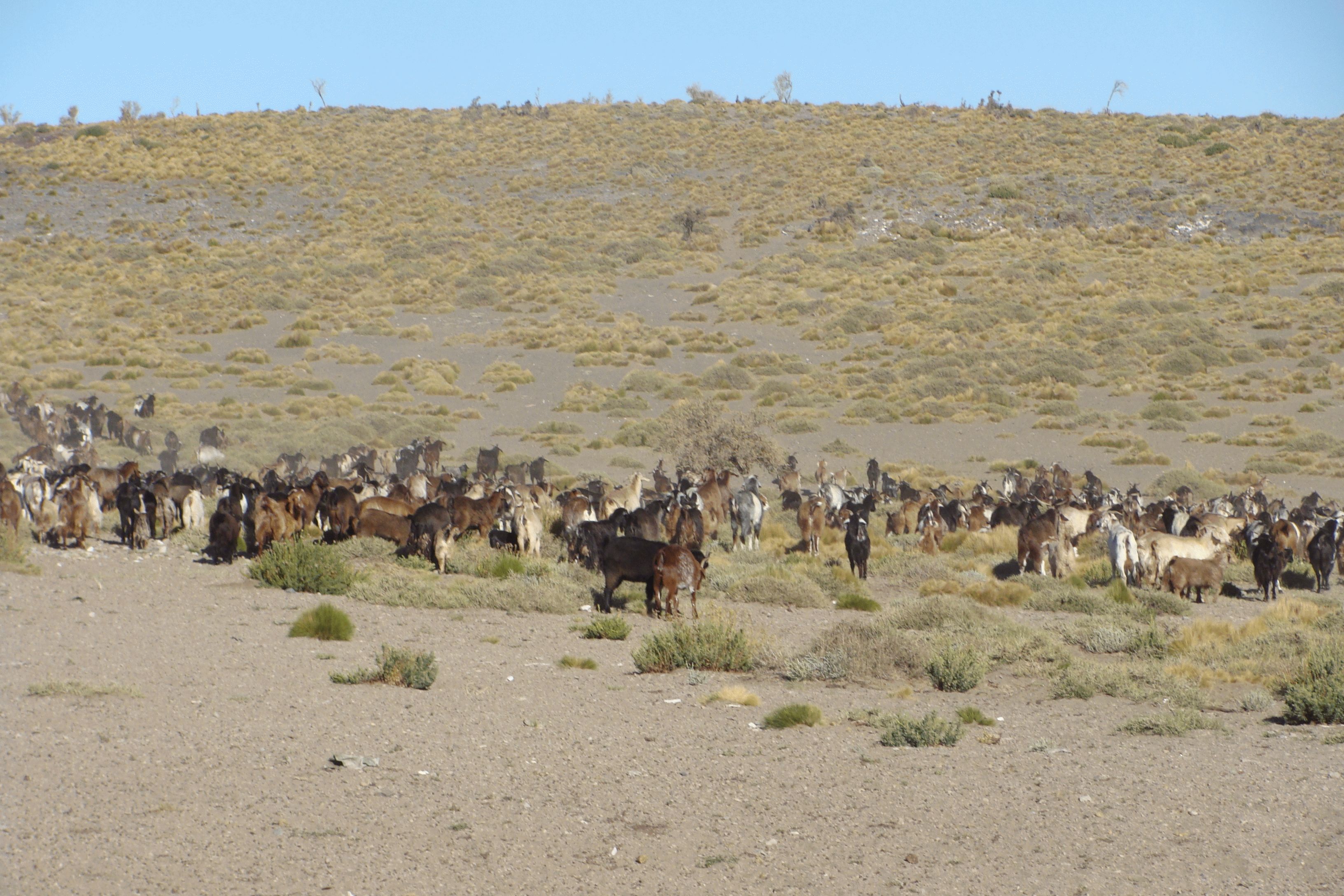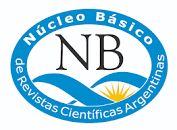Forage quality of goat intake, in the South Central Plateau of Mendoza (Argentina)
DOI:
https://doi.org/10.19137/cienvet202325202Keywords:
Goat production, Forage quality, Intake by simulationAbstract
The objective of this study was to determine the forage quality of goat intake in a natural pasture in the Meseta Central del Sur de Mendoza (Argentina). The test was carried out by simulating the goat intake with manual harvesting of the plant species that make up the intake of Creole goats under direct grazing, including the species that were present above 1% in each of the phenological moments. Six samples were simulated for each vegetative period and the percentage of Crude Protein, Neutral Detergent Fiber, Acid Detergent Fiber, Digestibility of Dry Mater (DMS) and Metabolic Energy (ME) were evaluated for each sample. The difference between the means according to phenological moment was made by ANAVA and Tukey's test, for the variables evaluated. The results obtained showed that at the time of regrowth is when the highest level of crude Protein (20.51±1.14%) and Expected Digestibility of Dry Matter (72.13±1.68%) shows the goat intake, with a significant statistical difference (p<0.05), in relation to the other phenological moments considered. Despite this, forage quality levels both in pre-flowering (13.92±0.83% and DEMS 67.66±2.27%) and in vegetative rest (P.B. 9.93±0.62% and DEMS 61.33±1.72%) can be considered good, since they are enough to cover the needs of the Creole goats used in this trial. It can be concluded by saying that the Criolla goat in direct grazing of the vegetation in the South Central Plateau of Mendoza maintains a good quality forage intake throughout the year based on the selection of the plant species it consumes.
Downloads
References
2. Mellado M. Dietary selection by goats and the implications for range management in the Chihuahuan Desert: a review. J. Rangel. Sci.2016; 38:331–341.
3. Hassen A, Rethman N, van Niekerk W, Tjelele T. Influence of season/year and species on chemical composition and in vitro digestibility of five Indigofera accessions. Anim. Feed Sci. Technol.2007; 136: 312–322.
4. Safari J, Mushi D, Kifaro G, Mtenga L, Eik L. Seasonal variation in chemical composition of native forages, grazing behaviour and some blood metabolites of Small East African goats in a semi-arid area of Tanzania. Anim. Feed Sci. Technol.2011;164: 62–70. https://doi.org/10.1016/j.anifeedsci.2010.12.004
5. Lugass R, Chudnovsky A, Zaady E, Dvash L, Goldshleger N. Estimating pasture quality of fresh vegetation based on spectral slope of mixed data of dry and fresh vegetation—Method development. Remote Sens.2015; 7:8045–8066.
6. Dayenoff P, Rosati V, Aguirre E, Bolaño M. Variación de la composición botánica de la dieta caprina, según el estado fenológico del pastizal natural. Primer Congreso Binacional de Producción Animal Argentina-Uruguay. 21° Congreso Argentino de Producción Animal. 2do Congreso Uruguayo de Producción Animal. Paysandú. R.O. del Uruguay. Revista Argentina de Producción Animal.1997; (1) 17, supl 1: 116.
7. Ramírez-Orduña R, Ramírez R, Gómez M, Armenta-Quintana J, Ramírez- Orduña J.; Cepeda-Palacios R. et al. Seasonal dynamics of ruminal crude protein digestion of browse species from Baja California Sur, México. Interciencia.2003; 28:408-414. Disponible en: http://ve.scielo.org/scielo.php?script=sci_arttext&pid=S0378-18442003000700009
8. Mellado M, Foote R, Rodríguez A, Zárate P. Botanical composition and nutrient content of diets selected by goats grazing on desert grassland in northern Mexico. Small Rumin. Res.1991; 6:141–150.
9. Dayenoff P. Contribución al Estudio de la Sustentabilidad de la Ganadería caprina en el Chaco-Arido, Argentina.1998.Tesis Doctoral. Facultad de Veterinaria. Universidad de Murcia. Murcia. España. 204 pp.
10. Dayenof P, Bolaño M, Aguirre E, Giovanardi F. Calidad forrajera de la ingesta caprina, en el Chaco-Arido (Argentina). "IIdo Congreso Latinoamericano de Especialistas en Pequeños Rumiantes y Camélidos Sudamericanos. Facultad de Veterinaria y Buiatría. Universidad Nacional Autónoma de México.2001. Mérida.
11. Chebli Y. El Otmani S, Chentouf M, Hornick JL, Cabaraux JF. Temporal Variations in Chemical Composition, In Vitro Digestibility, and Metabolizable Energy of Plant Species Browsed by Goats in Southern Mediterranean Forest Rangeland. Animals.2021;11, 1441; https://doi.org/10.3390/ani11051441
12. Echavarría Chaireza F, Gutiérrez Luna R, Ledesma Rivera R, Bańuelos Valenzuela R, Aguilera Soto J, Serna Pérez A. Influence of small ruminant grazing systems in a semiarid range in the State of Zacatecas Mexico. I Native vegetation. N Téc Pecu Méx.2006; 44:203-217.
13. Yayota M, Doi K. Goat Grazing for Restoring, Managing, and Conserving “Satoyama”, a Unique Socio-Ecological Production Landscape. Front. Sustain. Food Syst. 2020; 4:541721. doi: 10.3389/fsufs.2020.541721.
14. Cabrera AL. Regiones Fitogeográficas Argentinas. Enciclopedia Argentina de Agricultura y Jardinería. 1976. Fascículo1, Tomo 2. (1-85). Ed. ACME. Buenos Aires.
15. De Vries M. Estimating forage intake and quality in grazing cattle: A reconsideration of the hand-plucking method. J. Range Manage. 1995;48:370-375.
16. AOAC. Official Methods of Analices. 15th Edition. Association of Official Analytical Chemist. 1990. Washington. ISBN 0-935584-42-0. 771 pp.
17. Van Soest P, Robertson J, Lewis B. Methods for Dietary Fiber, Neutral Detergent Fiber, and Nonstarch Polysaccharides in Relation to Animal Nutrition. J Dairy Sci.1991; 74:3583-3597. DOI: 10.3168/jds.S0022-0302(91)78551-2
18. Fontana L, Ruiz M, Blain G, Babinec F, Romero N. Producción y calidad del forraje de alfafa y gramíneas megatérmicas en el año de implantación. Semiárida. Revista de la Facultad de Agronomía UNLPam. 2014; (24):21-29.
19. Rohweder D, Barnes R,Jorgensen, N. Pro-posed hay grading standards based on laboratory analyses for evaluating quality. J. Anim. Sci.1978; 47:747-759. DOI: 10.2527/jas1978.473747x
20. Dayenoff P, Moreno P, Dacar, Bolaño M. Composición florística de la ingesta caprina y bovina durante el período crítico (invierno), en Trintrica (Mendoza, Argentina). VI Congreso Latinoamericano de Especialistas en Pequeños Rumiantes y Camélidos Sudamericanos. ALEPRyCS-UNAM.2009. Querétaro, México.
21. Lei X, Li Y, Wang Z, Li Z, Chen L, Yang Y. Determination of ruminal dry matter and crude protein degradability and degradation kinetics of several concentrate feed ingredients in cashmere goat. J. Appl. Anim. Res.2008;46:134–140. https://doi.org/10.1080/09712119.2016.1276916.
22. Mountousis J, Papanikolaou K, Stanogias G, Chatzitheodoridis F, Roukos C. Seasonal variation of chemical composition and dry matter digestibility of rangelands in NW Greece. J. Centr. Eur. Agric. 2008;9:547-556. Disponible en: https://jcea.agr.hr/articles/635_SEASONAL_VARIATION_OF_CHEMICAL_COMPOSITION_AND_DRY_MATTER_DIGESTIBILITY_OF_RANGELANDS_IN_NW_GREECE_en.pdf
23. PapachristouT, Nastis A. Diets of goats grazing oaks shrublands of varying cover in Northeastn Greece. Journal of Range Management. 1993;46:220-226
24. Bhatta R, Shinde A, Sankhyan S, Verma DL. Nutrition of range goats in a shrubland of Western India. Asian Australasian journal of animal sciences.2002; 15:1719–1724. doi:10.5713/ajas.2002.1719.
25. Medina-Córdova N, Espinoza-Villavicencio J, Ávila-Serrano N, Murillo-Amador B. Composición química de forrajes del agostadero y su relación con la composición
química de leche de cabras criollas. Interciencia.2013; 38:132-138. Disponible en: https://www.redalyc.org/pdf/339/33926950008.pdf
26. Rubino R, Fedele V, Fizillo M. La capra al pascolo: attitudine al pascolamento e eficienza di utilizazione del pascolo. Agricultura ricerca.1988; 91:73-86.
27. Animut G, Goetsch A, Aiken G, Puchala R, Detweiler G, Krehbiel C, et al. Performance and forage selectivity of sheep and goats co-grazing grass/forb pastures at three stocking rates. Small Rumin. Res.2005; 59:2013–2015. Disponible en: https://pubag.nal.usda.gov/download/11062/pdf
28. NRC.Nutrients Requirements of Goats: Angora, Dairy and Meat Goats in Temperate and Tropical Countries. National Research Council National Academy Press.1981. Washington, DC, EEUU p. 23.
29. Dayenoff P, Silva J, Macario J, Dri P, Pizzaro J, Andrade-Montemayor H. Caracterización zoométrica de la cabra Criolla del sur de Mendoza. Revista Ciencia Veterinaria.2020; 22:97-118. ISSN 1515-1883. Disponible en: http://portal.amelica.org/ameli/journal/407/4071786003/4071786003.pdf
Contribuciones de autor
“Todos los autores contribuyeron a la concepción y el diseño del estudio. La preparación del material, la recopilación y el análisis de datos fueron realizados por Patricio Dayenoff, Javier Macario, Ignacio Kotani, José Luis Roberi, María Soledad Gorrachategui, Agustín Nicolás y Miguel Ángel Bolaño. El primer borrador del manuscrito fue escrito por Patricio Dayenoff y todos los autores comentaron las versiones anteriores del manuscrito. Todos los autores leyeron y aprobaron el manuscrito final." “Supervisión: Patricio Dayenoff
Conflicto de intereses
Los autores declaran por escrito, no tener vínculo o compromiso que condicione lo expresado en el artículo de su autoría y que pueda ser entendido como conflicto de intereses.

Downloads
Published
How to Cite
Issue
Section
License
Al momento de enviar sus contribuciones, los colaboradores deberán declarar , de manera fehaciente, que poseen el permiso del archivo o repositorio donde se obtuvieron los documentos que se anexan al trabajo, cualquiera sea su formato (manuscritos inéditos, imágenes, archivos audiovisuales, etc.), permiso que los autoriza a publicarlos y reproducirlos, liberando a la revista y sus editores de toda responsabilidad o reclamo de terceros , los autores deben adherir a la licencia Creative Commons denominada “Atribución - No Comercial CC BY-NC-SA”, mediante la cual el autor permite copiar, reproducir, distribuir, comunicar públicamente la obra y generar obras derivadas, siempre y cuando se cite y reconozca al autor original. No se permite, sin embargo, utilizar la obra con fines comerciales.






4.png)


7.png)



